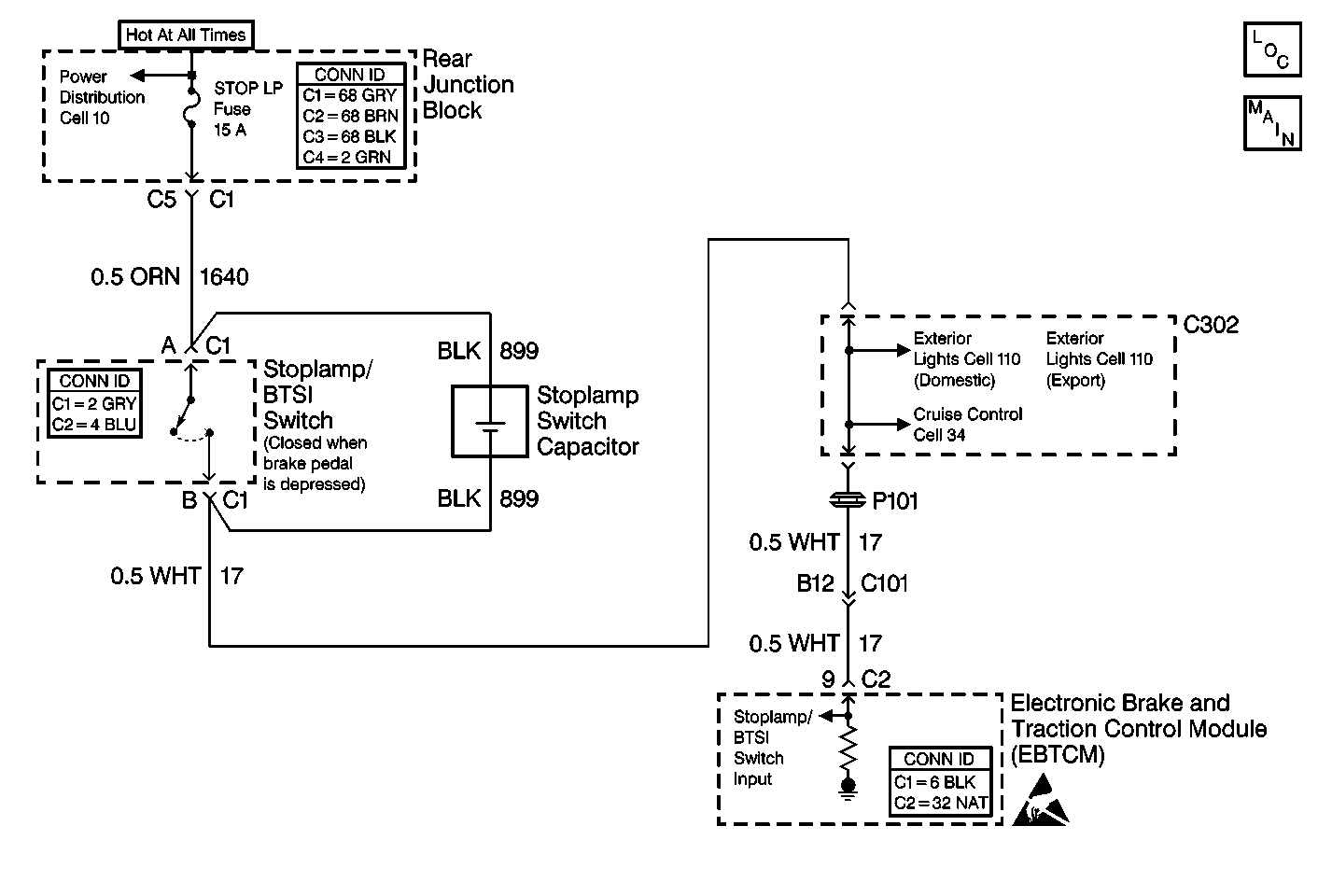
Circuit Description
This DTC is used in order to identify open stoplamp switch circuitry that prevents the stoplamp switch input from changing states when the brake is applied. This DTC is used in conjunction with DTC C1291 in order to determine the cause of an open stoplamp switch malfunction.
Conditions for Setting the DTC
This DTC sets after the following occur:
| • | Initialization is completed. |
| • | The stoplamp/BTSI switch input voltage is out of specification for 1 second (indicating an open circuit). |
Action Taken When the DTC Sets
| • | A malfunction DTC is stored. |
| • | The TCS is disabled. |
| • | The TRACTION CONTROL indicator is turned ON. |
| • | The ABS remains functional. |
Conditions for Clearing the DTC
| • | The condition for DTC is no longer present and you used scan tool Clear DTCs function. |
| • | The condition for DTC is no longer present and you used the On-Board Clear DTCs function. |
| • | The EBTCM does not detect the DTC in 50 drive cycles. |
Diagnostic Aids
| • | It is very important that a thorough inspection of the wiring and connectors be performed. Failure to carefully and fully inspect wiring and connectors may result in misdiagnosis, causing part replacement with reappearance of the malfunction. |
| • | An intermittent malfunction can be caused by poor connections, broken insulation, or a wire that is broken inside the insulation. |
| • | If an intermittent malfunction exists, refer to Intermittents and Poor Connections Diagnosis in Wiring Systems. |
| • | This condition may be cause by the following: |
| - | The stoplamp/BTSI switch circuit is open. |
| - | All brake lamps are open. |
| - | The brake lamp switch is open or misadjusted. |
| - | The brake lamp ground is open. |
| - | The circuit has a wiring problem, terminal corrosion, or poor connections. |
Test Description
The numbers below refer to step numbers on the diagnostic table.
Step | Action | Value(s) | Yes | No |
|---|---|---|---|---|
1 | Did you perform the Diagnostic System Check? | -- | Go to Step 2 | Go to Diagnostic System Check |
2 | Press the brake pedal. Do the brake lamps turn on? | -- | Go to Step 3 | Go to Step 6 |
Is the voltage within the specified range? | Battery Voltage | Go to Step 4 | Go to Step 5 | |
4 | Replace the EBTCM. Refer to Electronic Brake Control Module Replacement . Did you complete the repair? | -- | Go to Diagnostic System Check | -- |
5 | Repair the open in CKT 17. Refer to Wiring Repairs in Wiring Systems. Did you complete the repair? | -- | Go to Diagnostic System Check | -- |
6 | Check the rear junction block STOP LP Fuse. Is the fuse good? | -- | Go to Step 7 | Go to Step 11 |
7 |
Is the voltage within the specified range? | Battery Voltage | Go to Step 9 | Go to Step 8 |
8 | Repair the open in CKT 1640. Refer to Wiring Repairs in Wiring Systems. Did you complete the repair? | -- | Go to Diagnostic System Check | -- |
Connect a fused jumper wire between the stoplamp/BTSI switch harness connector C1 terminals A and B. Do the brake lamps come on? | -- | Go to Step 10 | Go to Step 5 | |
10 | Adjust or repair the stoplamp/BTSI switch as necessary. Refer to Stop Lamp Switch Replacement or Stop Lamp Switch Adjustment in Hydraulic Brakes. Did you complete the repair? | -- | Go to Diagnostic System Check | -- |
11 |
Is the fuse good? | -- | Go to Step 13 | Go to Step 12 |
12 | Repair short to ground in CKT 1640. Refer to Wiring Repairs in Wiring Systems. Did you complete the repair? | -- | Go to Diagnostic System Check | -- |
13 |
Is the fuse good? | -- | Go to Diagnostic System Check | Go to Step 14 |
14 |
Is the fuse good? | -- | Go to Step 4 | Go to Step 15 |
15 | Repair short to ground in CKT 17. Refer to Wiring Repairs in Wiring Systems. Did you complete the repair? | -- | Go to Diagnostic System Check | -- |
